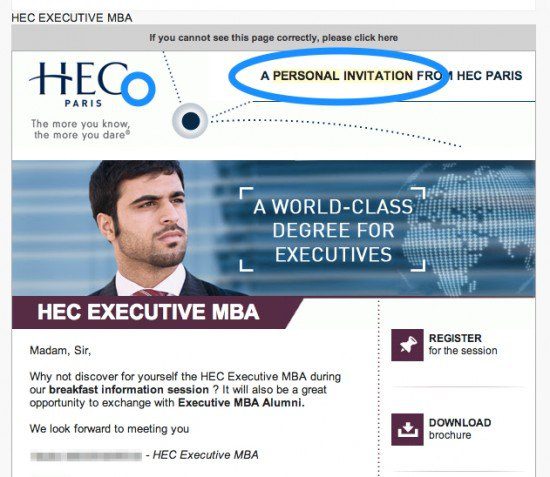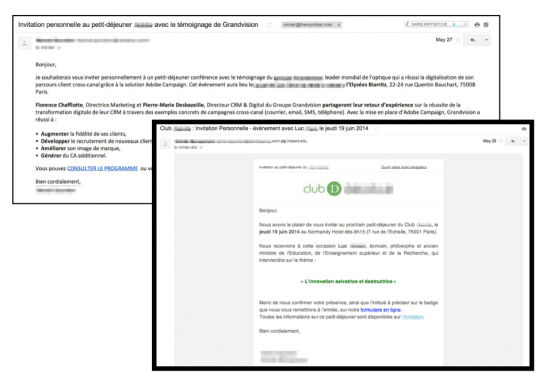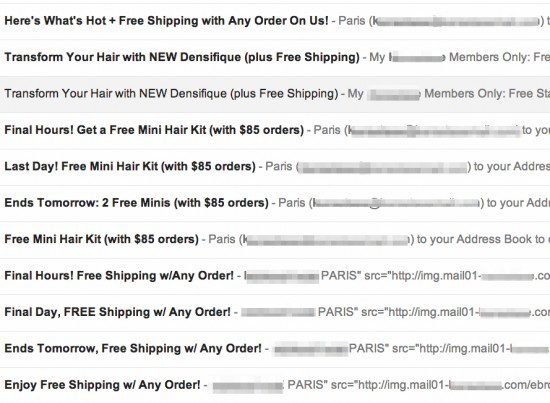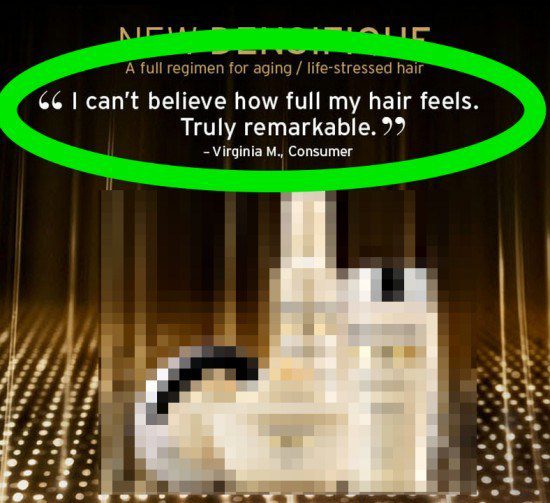For many brands and marketing teams in businesses around the world, there is terrific pressure to improve performance. Many a marketing strategy blueprint will include projects with bold Calls to Action, such as:
- Optimize CRM program
- Increase conversion rates
- Drive down acquisition costs
- Build email database
- Drive word of mouth
- Create influencer program
and, in this series, my favorite:
- Digitalize our business (as if it were an objective/strategy unto itself)
These actions all have their sense and can be entirely valid, especially if they are aligned with the brand’s overall objectives. However, too often, the execution breaks down. Big data is a beautiful concept. In reality, it remains wholly abstract for most marketing teams. To wit, recently, I received of few examples of what I would characterize as bad by-products of the above calls to action.
The (im)personal invitation
Most of the action plans above will rely, in one way or another, on the email, a bastion of digital marketing. With all the new technologies and talk of big data, there are great opportunities to create engaging and personalized communications, even conversations. Yet, for all the talk, it seems that the basics still elude us — even big name companies and brands. Below is is “personal invitation” I received recently from the renowned HEC business school. In my world, call me crazy, but a personal invitation should be…. personalized. The most basic of email services enable personalization of the name field. Not only do they not mention my name, they don’t bother to specify my sex. How on earth can this constitute a “personal invitation”?
To think some agency was paid to create and send out this email…!
Personal invitation – walking the talk…
However, HEC is not alone. Below are a couple more examples of impersonal personal invitations (in French). In one case, the topic of the breakfast to which I was being invited was, ironically, on CRM – customer relationship management. I cannot but re-emphasize the need for agencies and consultants to walk the talk before trying to garner someone else’s (i.e. a potential client’s) attention (and trust).
What’s the easy fix? If, for your intended distribution list, you don’t the full name and sex, then don’t pretend to be sending out a personal invitation! {Tweet this!} Ideally, though, the data collection is such that first and last names are being captured, etc.
The latent harassment
As brands continue to increase their digital marketing budgets and, in many cases, push toward eCommerce, I have seen many of them stoop to rather unfortunate practices. Among these practices is overwhelming the distribution list with overly frequent emails, ineffective personalization and content that is bereft of utility, values or purpose. Having tracked emails from a number of important brands over the years, I have seen brands that pretend to be luxury act in a manner no different than low-end catalog companies. Below is a compilation of email headlines from a ”luxury” brand which sends out an email roughly 6x/week. I would argue that not only is the frequency too high, but the email headlines are borderline harassment in terms of tone. (N.B. In a great lapse of execution, this brand send out the same mail twice in one day, with an interval of 1.5 hours). With calls to action such as “Final Day,” “Final Hour” or “Ends Tomorrow,” there seems to be a sentiment of urgency, if not desperation.
Building trust
When a brand’s DNA is deeply ingrained in its product and is less about the customer, the default position is ‘push.’ There is something inherently low end in the need to scare the customer into a purchase. It breeds mistrust. To wit, when this particular company wanted to give credibility its product with a customer review, it went so far as to insist that the review was from a “Consumer” (see below). One has to wonder how little trust exists if the brand needs to actually write that Virginia M. isn’t a stooge!
The consumer journey
Getting CRM right is a journey unto itself, especially in this omni-channel world in which we now exist. Increasingly, brands are having to come to grips with the consumer journey. At its heart, this means being able to step into the shoes of the customer, hence the need for better listening skills and more empathy. For product-centric organizations that have “grown up” on push marketing techniques and tactics, this can be a tall order. What to do about it? I would argue, first, that an agency that is continuing to help pump out messages and email campaigns such as the ones we have seen above should be called into question. Secondly, I would invite all senior executives to review, with commensurate distance, the types of campaigns on which they and their teams are signing off. Finally, and more painfully, senior management needs to ask itself: is there a dedicated long-term intention to make sure that the values of the brand are being lived and exercised on a daily basis by the employees first and foremost? Brand communications that are stripped of personality, merely driving out commercial messages, are putting the equity of the brand at risk. {Tweet this!}
















Great article Minter, thank you. I totally agree that personalisation, when
implemented poorly can be more damaging to a brand but I also think companies need to be wary of over-personalisation otherwise the consumer can feel stalked, digitally. Google Adsense is a prime example of latent harassment, which doesn’t just come in the form of repetitive emails. And in a similar ilk, the volume of content promoted should be equally measured, not simply by the number of leads generated but more importantly by the number of unsubscribes. If you are sending too many emails, your audience will soon let you know by unsubscribing and therefore it is important to find a balancing act. Finally, I have to admit to using case studies to build trust and you are right does not work. However, recently I have started to offer a link to the ‘about us’ web page within our email campaigns and this has proven high successful in building trust and brand awareness. In my experience, presenting yourself, only encourages consumers to find out more and through their web trawl, they will find case studies in a more legitimate search process.
Anita Holley
Maximizer CRM
http://www.max.co.uk